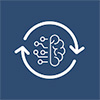| May 26, 2023 |
|
(Nanowerk News) Chiral nanostructures can enhance the weak inherent chiral effects of biomolecules and highlight the important roles in chiral detection. However, the design of the chiral nanostructures is challenged by extensive theoretical simulations and explorative experiments. Recently, Zheyu Fang’s group proposed a chiral nanostructure design method based on reinforcement learning, which can find out metallic chiral nanostructures with a sharp peak in circular dichroism spectra and enhance the chiral detection signals. This work envisions the powerful roles of artificial intelligence in nanophotonic designs.
|
|
Chirality is a fundamental physical property which means that an object or structure cannot be superposed to its mirror image. It plays important role in biomedical sensing, as enantiomers with opposite handedness lead to dramatically different biological effects. However, it is challenging to detect trace-amount enantiomers, since the chiral bio-molecules are quite smaller than the optical wavelengths and present weak dichroism signals.
|
|
Chiral plasmonic nanostructures have been employed to enhance the interactions between the optical waves and the chiral molecules. Common dichroism technologies are based on circularly polarized waves, i.e. the spin angular momenta (SAM) of photons. Chiral metasurfaces, metamaterials, and nanoparticles can be employed to enhance the sensing signal since their intrinsic circular dichroism (CD) signals can be sensitively affected by chiral biomolecules. In recent years, dichroism technologies based on orbital angular momenta (OAM) have been proposed and investigated, in which the dichroism signal is defined based on the differential response spectra of opposite vortex modes. Plasmonic resonant structures with intrinsic chirality can also enhance the dichroism signals based on OAM.
|
|
However, the interactions between chiral molecules and chiral nanostructures are complex. Different biomolecules may require different nanostructures to reach the optimally enhanced dichroism signals. Hence, the design of the chiral nanostructures consumes huge computing resources in iterative electromagnetic (EM) simulations. Artificial intelligence (AI) emerges as a powerful tool in nanostructure designing, which can deal with more complex problems and larger-scale data compared with traditional optimization algorithms. AI has been successfully used in the design of metasurfaces, photonic crystals, integrated wavelength routers, etc.
|
|
In a recent paper published in Opto-Electronic Science (“Chiral detection of biomolecules based on reinforcement learning”), Zheyu Fang and his colleagues propose a method for chiral nanostructure design based on reinforcement learning (Fig. 1), in which the exploration of new nanostructures and the update of models are simultaneous.
|
 |
| Figure 1. The design workflow of the chiral nanostructures based on reinforcement learning. (© Opto-Electronic Science)
|
|
The introduction of reinforcement learning improves the quality of the training dataset and reduces the EM simulation amounts. Fig. 1(a) presents the construction of the training dataset. Different nanostructures are created randomly at the start, and their optical responses are calculated by EM simulations. As shown in Fig. 1(b), the next step is to train several artificial neural networks (ANNs) to obtain the mapping relations between the nanostructure geometries and their spectra. Then, new structures are designed with a Bayesian optimization algorithm based on predictions from ANNs (Fig. 1(c)).
|
|
The ANNs recognize nanostructures with strong chirality, generate possibly optimized structures, and decrease the computing resource spent on weakly chiral nanostructures. Figure 1(d) demonstrates the updating process of the training dataset. For nanostructures whose optical responses predicted by different ANNs differ significantly, their optical responses will be calculated by EM simulations. The inaccuracies of the ANNs indicate that there are few similar structures in the current dataset, hence the simulated data are added to the training dataset.
|
|
For those nanostructures predicted consistently by different ANNs, there should already be similar structures in the training dataset. After the data update, the ANNs are retrained. Therefore, ANNs ensure that the nanostructures added to the dataset have the potentials of strong chirality although the initial dataset is constructed randomly.
|
|
To execute the proposed scheme, the chiral unit to be designed is parameterized by 40×40 units encoded with 0 or 1, which represents that a gold cuboid or air exists at that position. ANNs achieve the mapping between the optical response spectra and the matrixes which represent the geometry. As last, three chiral metasurfaces with different CD peak frequencies are designed. The chiral metasurfaces are also fabricated and measured to validate the proposed method. The experimental results are consistent with the designed results. The frequency shifts of the CD spectra caused by chiral molecules are also measured using left-glucose and right-glucose solutions controlled by microfluidic channels. The resonance wavelength shifts between enantiomers of glucose with opposite chirality reach 7 nm, which indicates enhanced sensitivity of the chiral molecules.
|
|
The proposed method improves the quality of the training dataset and reduces the electromagnetic simulation amounts compared with classical exploration methods. Chiral nanostructures with significant CD values and high chiral detection sensitivity have been successfully designed and fabricated. Besides the demonstrated chiral nanophotonic designs, other optical properties can be also designed since the algorithm is universal for any physical meanings of the optical responses. This work envisions the promising applications of AI in nanophotonic and electromagnetic designs.
|


